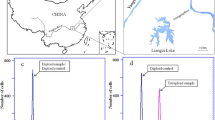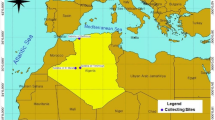Abstract
In order to study how polyploidy affects life history patterns in animals, we have examined sympatric diploid and polyploid brine shrimp (Artemia parthenogenetica) from China, Italy and Spain under laboratory conditions. At optimal temperature and salinity (25°C and 90 ppt), diploids from the three populations had much higher intrinsic rates of increase, higher fecundity, faster developmental rates, and larger brood sizes than their sympatric polyploids. The Chinese and Italian populations were selected for further analysis to determine the life history responses of diploids and polyploids to temperature and salinity changes. Under intermediate and high salinities, Chinese and Italian polyploids produced most of their offspring as dormant cysts while their sympatric diploids produced most of their offspring as nauplii. This relationship is reversed in the Spanish diploid-polyploid complex. For the Chinese population at 25° C, pentaploid clones had higher developmental rates than diploid clones at 35 ppt; at 90 ppt, diploid clones had higher developmental rates than the pentaploids. Italian diploids and tetraploids had different responses to variation in both temperature (25° C and 31° C) and salinity (30 ppt and 180 ppt). Our results demonstrate that relative fitness of the two cytotypes is a function of environmental conditions and that sympatric diploids and polyploids respond differently to environmental changes. Chinese and Italian polyploids are expected to have lower fitness than their sympatric diploids when the physical environment is not stressful and when intraspecific competition is important. However, polyploids may have advantages over sympatric diploids in stressful habitats or when they encounter short-term lethal temperatures. These results suggest that polyploid Artemia have evolved a suite of life-history characteristics adapting them to environments that contrast to those of their sympatric diploids.
Similar content being viewed by others
References
Abreu-Grobois F, Beardmore JA, (1982) Genetic differentiation and speciation in the brine shrimp, Artemia. In: C. Barigozzi (ed), Mechanisms of speciation. Alan R. Liss, New York. pp 221–252
Amat Domenech F (1980) Differentiation in Artemia strains from Spain. In: Persoone G, Sorgeloos P, Roels O, Jaspers E (eds), The Brine shrimp Artemia. Vol. 1 Universa Press, Wetteren, Belgium. pp. 19–40
Beaton MJ, Hebert PDN, (1988) Geographical parthenogenesis and polyploidy in Daphnia pulex. Am Nat 132: 837–845
Bierzychudek P (1985) Patterns in plant parthenogenesis. Experimentia 41: 1255–1263
Birch LC (1948) The intrinsic rate of increase of an insect population. J Animal Ecol 27: 15–26
Bowen ST, Sterling G (1978) Esterase and malate dehydrogenase isozyme polymorphism in 15 Artemia populations. Comp Biochem Physiol 61: (B), 593–595
Browne RA, Bowen ST (1991) Taxonomy and population genetics of Artemia. In: Browne RA, Sorgeloos P, Trotman CN (eds), Artemia Biology. CRC Press. pp. 221–235
Browne RA, Sallee SE, Grosch DS, Segreti WQ, Perser SM (1984) Partitioning genetic and environmental components of reproduction and lifespan in Artemia. Ecology 65: 949–960
Browne RA, Davis LE, Sallee SE (1988) Effects of temperature and relative fitness of sexual and asexual brine shrimp Artemia. J Exp Mar Biol Ecol 124: 1–20
Cavaller-Smith T (1985) Cell volume and the evolution of eukaryotic genome size. In: Cavaller-Smith T (ed), The evolution of genome size. Wiley and Sons. pp. 105–184
Dewey DR (1980) Some applications and misapplications of induced polyploidy to plant breeding. In: Lewis WH (ed) Polyploidy: biological relevance. Plenum Press, New York, pp. 445–470
Gajardo GM, Beardmore JA (1989) Ability to switch reproductive mode in Artemia is related to maternal heterozygosity. Mar Ecol Prog Ser 55: 191–195
Goin OB, Goin CJ, Bachmann K (1968) DNA and amphibian life history. Capiea 3: 532–540
Hebert PDN, Emery CJ (1990) The adaptive significance of cuticular pigmentation in Daphnia. Funct Ecol 4: 703–710
King CE, Zhao YQ, Liu X, Li MR (1988) Genetic variation in parthenogenetic Artemia from the Shandong Peninsula, PRC Chinese J Oceanol Limnol 6: 179–185
Lenz PH, Browne RA (1991) Ecology of Artemia. In: Browne RA, Sorgeloos P, Trotman CN (eds.), Artemia Biology. CRC Press, pp 237–253
Lewis WH (1980) Polyploidy in species populations. In: Lewis WH (ed) Polyploidy: biological relevance. Plenum Press, New York, pp 103–144
Levin DA, (1983) Polyploidy and novelty in flowering plants. Am Nat 122: 1–25
Lumaret R, Guillerm JL, Delay J, Ait Lhaj Loutfi A, Izco J, Jay M (1987) Polyploidy and habitat differentiation in Dactylis glomerata L. from Galicia (Spain). Oecologia 73: 436–446
Macisaac HJ, Hebert PDN, Schwartz SS, (1985) Inter- and intraspecific variation in acute thermal tolerance of Daphnia. Physiol Zool 58: 350–355
Suomalainen E, Saura A, Lokki J (1987) Polyploidy in association with parthenogenesis. In: Suomalainen E, Saura A, Lokki J (eds), Cytology and evolution in parthenogenesis. CRC Press, Inc. Florida. pp. 71–112
Tackaert W, Sorgeloos P (1991) Semi-intensive culturing in fertilized ponds. In: Browne RA, Sorgeloos P, Trotman CNA (eds), Artemia Biology CRC press, pp 287–315
Van Dijk P, Van Delden W (1990) Evidence for autotetraploidy in Plantago media and comparisons between natural and artificial cytotypes concerning cell size and fertility. Heredity 65: 349–357
Vanhaecke P, Siddall SE, Sorgeloos P (1984) International study on Artemia. XXXII. Combined effects of temperature and salinity on the survival of Artemia of various geographic origin. J Exp Mar Biol Ecol 80: 259–275
Walsh E, Zhang L (1992) Polyploidy and body size variation in a natural rotifer Euchlanis dilatata population. J Evol Biol 5: 345–353
Wang RX, Cai YN, Li JY (1991) Clonal and chromosome study of parthenogenetic brine shrimp (Artemia parthenogenetica) from north China. Oceanologia et Limnologia Sinica 22: 1–8
Weider LJ (1987) Life history variation among low-arctic clones of obligately parthenogenetic Daphnia pulex: a diploid-polyploid complex. Oecologia 73: 251–256
Zhang L, Lefcort H (1991) The effects of ploidy level on the thermal distributions of brine shrimp Artemia parthenogenetica and its ecological implications. Heredity 66: 445–452
Zhang L, King CE, (1992) Genetic variation of the sympatric populations of diploid and polyploid brine shrimp (Artemia parthenogenetica). Genetica 85: 211–221
Author information
Authors and Affiliations
Rights and permissions
About this article
Cite this article
Zhang, L., King, C.E. Life history divergence of sympatric diploid and polyploid populations of brine shrimp Artemia parthenogenetica . Oecologia 93, 177–183 (1993). https://doi.org/10.1007/BF00317668
Received:
Accepted:
Issue Date:
DOI: https://doi.org/10.1007/BF00317668




